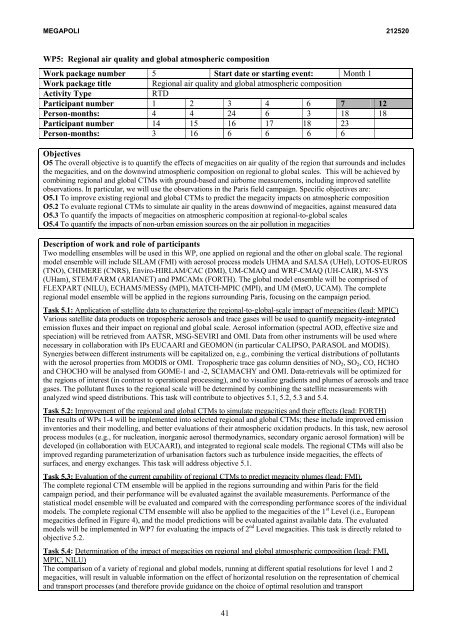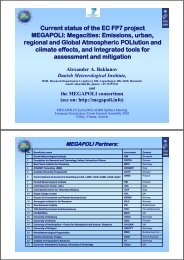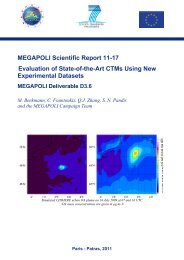D E S C R I P T I O N O F W O R K - MEGAPOLI - Dmi
D E S C R I P T I O N O F W O R K - MEGAPOLI - Dmi
D E S C R I P T I O N O F W O R K - MEGAPOLI - Dmi
Create successful ePaper yourself
Turn your PDF publications into a flip-book with our unique Google optimized e-Paper software.
<strong>MEGAPOLI</strong> 212520<br />
WP5: Regional air quality and global atmospheric composition<br />
Work package number 5 Start date or starting event: Month 1<br />
Work package title Regional air quality and global atmospheric composition<br />
Activity Type RTD<br />
Participant number 1 2 3 4 6 7 12<br />
Person-months: 4 4 24 6 3 18 18<br />
Participant number 14 15 16 17 18 23<br />
Person-months: 3 16 6 6 6 6<br />
Objectives<br />
O5 The overall objective is to quantify the effects of megacities on air quality of the region that surrounds and includes<br />
the megacities, and on the downwind atmospheric composition on regional to global scales. This will be achieved by<br />
combining regional and global CTMs with ground-based and airborne measurements, including improved satellite<br />
observations. In particular, we will use the observations in the Paris field campaign. Specific objectives are:<br />
O5.1 To improve existing regional and global CTMs to predict the megacity impacts on atmospheric composition<br />
O5.2 To evaluate regional CTMs to simulate air quality in the areas downwind of megacities, against measured data<br />
O5.3 To quantify the impacts of megacities on atmospheric composition at regional-to-global scales<br />
O5.4 To quantify the impacts of non-urban emission sources on the air pollution in megacities<br />
Description of work and role of participants<br />
Two modelling ensembles will be used in this WP, one applied on regional and the other on global scale. The regional<br />
model ensemble will include SILAM (FMI) with aerosol process models UHMA and SALSA (UHel), LOTOS-EUROS<br />
(TNO), CHIMERE (CNRS), Enviro-HIRLAM/CAC (DMI), UM-CMAQ and WRF-CMAQ (UH-CAIR), M-SYS<br />
(UHam), STEM/FARM (ARIANET) and PMCAMx (FORTH). The global model ensemble will be comprised of<br />
FLEXPART (NILU), ECHAM5/MESSy (MPI), MATCH-MPIC (MPI), and UM (MetO, UCAM). The complete<br />
regional model ensemble will be applied in the regions surrounding Paris, focusing on the campaign period.<br />
Task 5.1: Application of satellite data to characterize the regional-to-global-scale impact of megacities (lead: MPIC)<br />
Various satellite data products on tropospheric aerosols and trace gases will be used to quantify megacity-integrated<br />
emission fluxes and their impact on regional and global scale. Aerosol information (spectral AOD, effective size and<br />
speciation) will be retrieved from AATSR, MSG-SEVIRI and OMI. Data from other instruments will be used where<br />
necessary in collaboration with IPs EUCAARI and GEOMON (in particular CALIPSO, PARASOL and MODIS).<br />
Synergies between different instruments will be capitalized on, e.g., combining the vertical distributions of pollutants<br />
with the aerosol properties from MODIS or OMI. Tropospheric trace gas column densities of NO2, SO2, CO, HCHO<br />
and CHOCHO will be analysed from GOME-1 and -2, SCIAMACHY and OMI. Data-retrievals will be optimized for<br />
the regions of interest (in contrast to operational processing), and to visualize gradients and plumes of aerosols and trace<br />
gases. The pollutant fluxes to the regional scale will be determined by combining the satellite measurements with<br />
analyzed wind speed distributions. This task will contribute to objectives 5.1, 5.2, 5.3 and 5.4.<br />
Task 5.2: Improvement of the regional and global CTMs to simulate megacities and their effects (lead: FORTH)<br />
The results of WPs 1-4 will be implemented into selected regional and global CTMs; these include improved emission<br />
inventories and their modelling, and better evaluations of their atmospheric oxidation products. In this task, new aerosol<br />
process modules (e.g., for nucleation, inorganic aerosol thermodynamics, secondary organic aerosol formation) will be<br />
developed (in collaboration with EUCAARI), and integrated to regional scale models. The regional CTMs will also be<br />
improved regarding parameterization of urbanisation factors such as turbulence inside megacities, the effects of<br />
surfaces, and energy exchanges. This task will address objective 5.1.<br />
Task 5.3: Evaluation of the current capability of regional CTMs to predict megacity plumes (lead: FMI).<br />
The complete regional CTM ensemble will be applied in the regions surrounding and within Paris for the field<br />
campaign period, and their performance will be evaluated against the available measurements. Performance of the<br />
statistical model ensemble will be evaluated and compared with the corresponding performance scores of the individual<br />
models. The complete regional CTM ensemble will also be applied to the megacities of the 1 st Level (i.e., European<br />
megacities defined in Figure 4), and the model predictions will be evaluated against available data. The evaluated<br />
models will be implemented in WP7 for evaluating the impacts of 2 nd Level megacities. This task is directly related to<br />
objective 5.2.<br />
Task 5.4: Determination of the impact of megacities on regional and global atmospheric composition (lead: FMI,<br />
MPIC, NILU)<br />
The comparison of a variety of regional and global models, running at different spatial resolutions for level 1 and 2<br />
megacities, will result in valuable information on the effect of horizontal resolution on the representation of chemical<br />
and transport processes (and therefore provide guidance on the choice of optimal resolution and transport<br />
41




